Abstract
Gastric acid production, unstimulated and following stimulation with betazole hydrochloride, was measured in Indian men with cholera or acute vibrio-negative diarrhoea-Measurements were made during acute illness and after different periods of convalescence. Men from the same socioeconomic group and from a higher one served as controls. Stimulated acid production was severely reduced during diarrhoea caused by V. cholerae and related vibrios but not during acute vibrio-negative diarrhoea. Acid production returned to stable convalescent values 1-3 days after cessation of diarrhoea. Stimulated acid production was significantly lower in controls from the lower socioeconomic group than in those from the higher socioeconomic group. Achlorhydria that did not respond to betazole administration occurred in 32% of the convalescent cholera patients but in none of the controls or convalescent vibrio-negative diarrhoea patients. It is concluded from these results that diarrhoea produced by V. cholerae and related vibrios is accompanied by transient inhibition of gastric acid secretion, that cholera occurs largely in a population with impaired acid secretion, and that preexisting achlorhydria may predispose to infection with V. cholerae.
Full text
PDF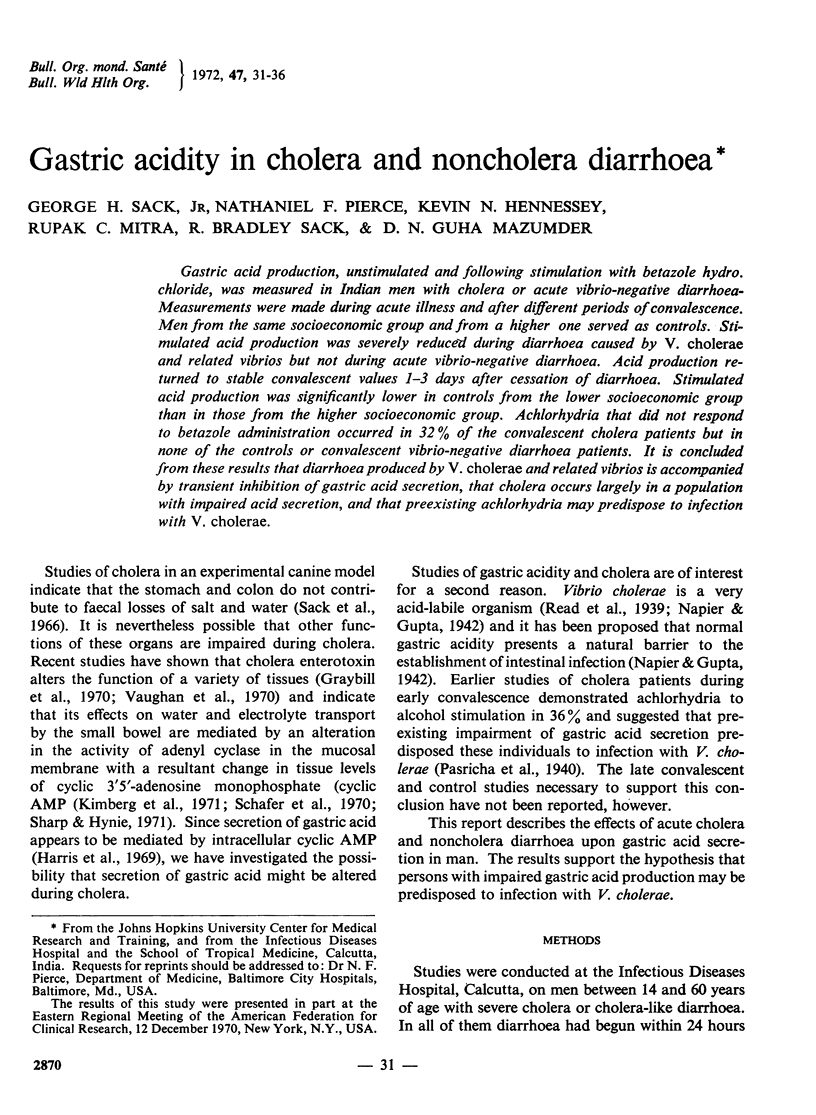

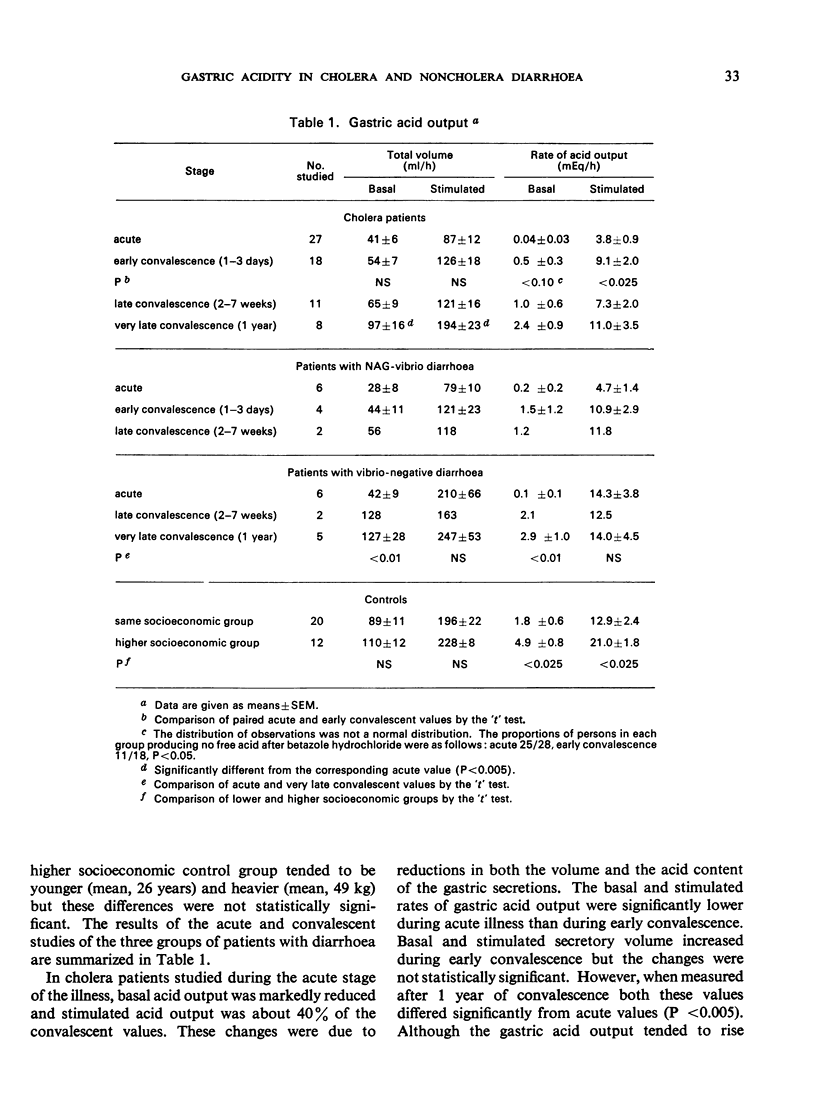
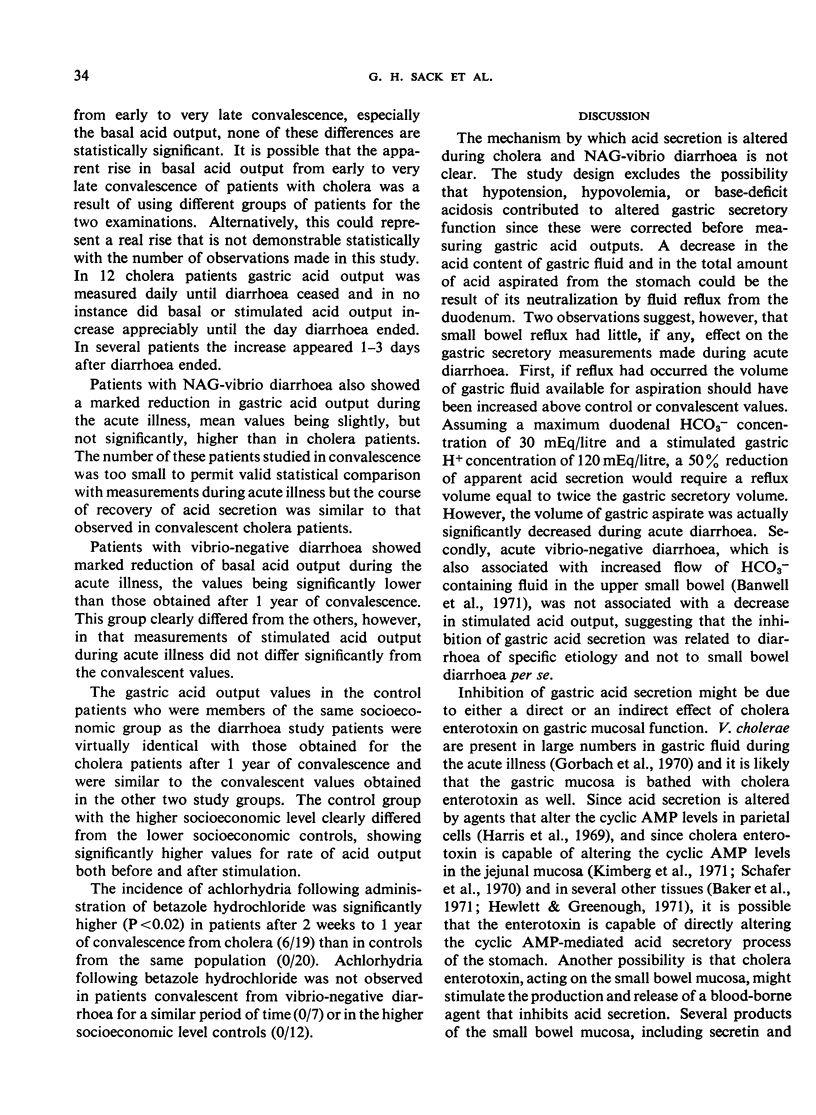
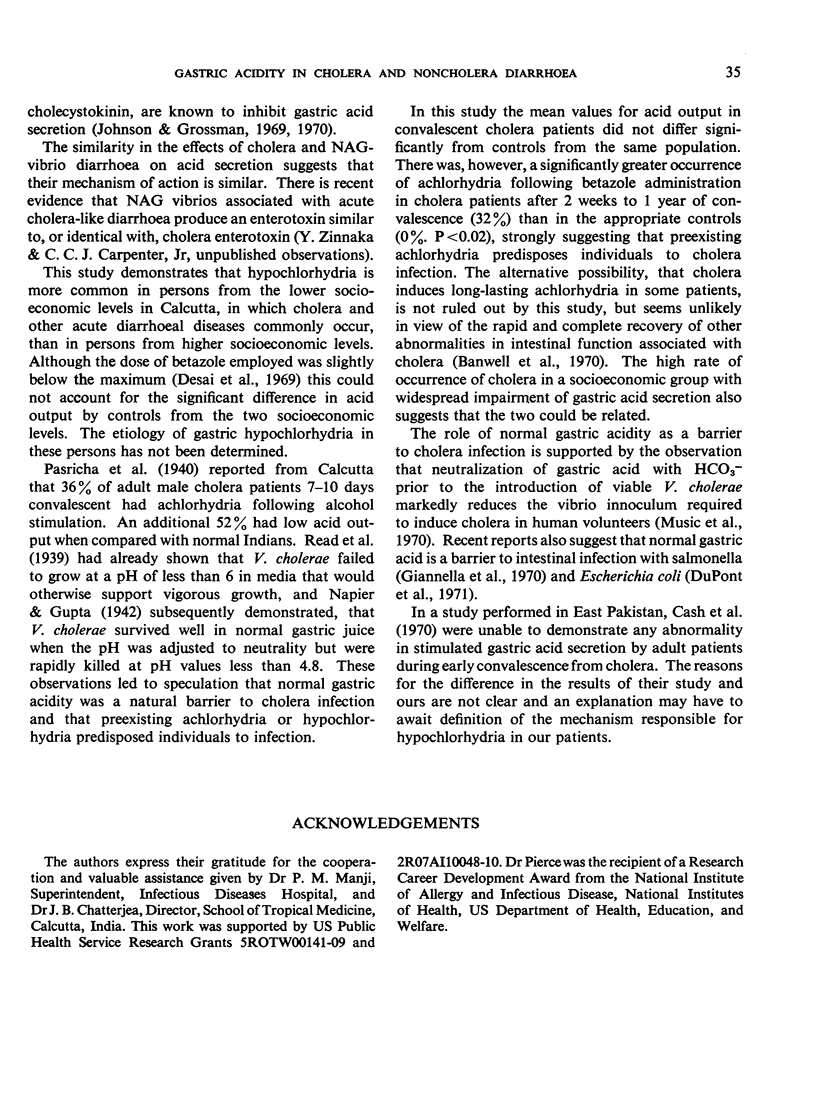
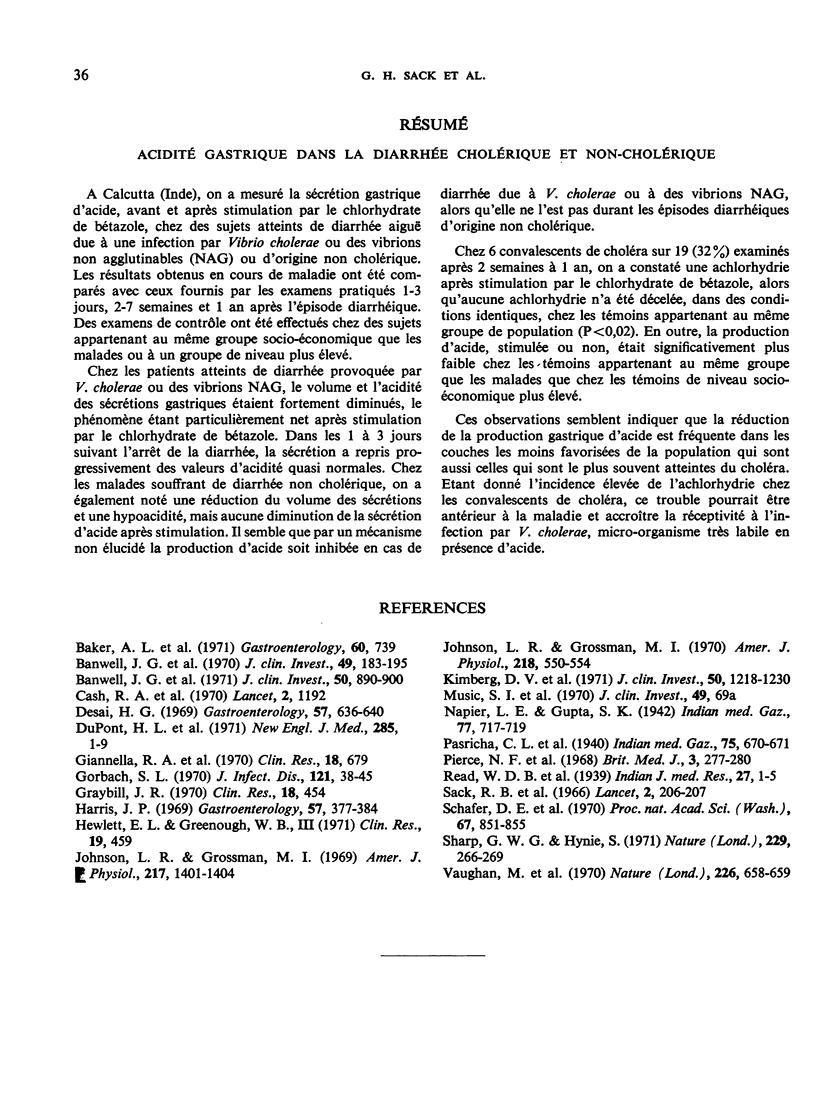
Selected References
These references are in PubMed. This may not be the complete list of references from this article.
- Banwell J. G., Gorbach S. L., Pierce N. F., Mitra R., Mondal A. Acute undifferentiated human diarrhea in the tropics. II. Alterations in intestinal fluid and electrolyte movements. J Clin Invest. 1971 Apr;50(4):890–900. doi: 10.1172/JCI106561. [DOI] [PMC free article] [PubMed] [Google Scholar]
- Banwell J. G., Pierce N. F., Mitra R. C., Brigham K. L., Caranasos G. J., Keimowitz R. I., Fedson D. S., Thomas J., Gorbach S. L., Sack R. B. Intestinal fluid and electrolyte transport in human cholera. J Clin Invest. 1970 Jan;49(1):183–195. doi: 10.1172/JCI106217. [DOI] [PMC free article] [PubMed] [Google Scholar]
- Cash R. A., Alam J., Toaha K. M. Gastric acid secretion in cholera patients. Lancet. 1970 Dec 5;2(7684):1192–1192. doi: 10.1016/s0140-6736(70)90379-x. [DOI] [PubMed] [Google Scholar]
- Desai H. G., Anta P., Gupte U. V., Potnis P. R. Dose of histamine for maximal stimulation of gastric acid secretion. Modified subcutaneous histamine test. Gastroenterology. 1969 Dec;57(6):636–640. [PubMed] [Google Scholar]
- DuPont H. L., Formal S. B., Hornick R. B., Snyder M. J., Libonati J. P., Sheahan D. G., LaBrec E. H., Kalas J. P. Pathogenesis of Escherichia coli diarrhea. N Engl J Med. 1971 Jul 1;285(1):1–9. doi: 10.1056/NEJM197107012850101. [DOI] [PubMed] [Google Scholar]
- Gorbach S. L., Banwell J. G., Jacobs B., Chatterjee B. D., Mitra R., Brigham K. L., Neogy K. N. Intestinal microflora in Asiatic cholera. II. The small bowel. J Infect Dis. 1970 Jan;121(1):38–45. doi: 10.1093/infdis/121.1.38. [DOI] [PubMed] [Google Scholar]
- Harris J. B., Nigon K., Alonso D. Adenosine-3',5'-monophosphate: intracellular mediator for methyl xanthine stimulation of gastric secretion. Gastroenterology. 1969 Oct;57(4):377–384. [PubMed] [Google Scholar]
- Johnson L. R., Grossman M. I. Analysis of inhibition of acid secretion by cholecystokinin in dogs. Am J Physiol. 1970 Feb;218(2):550–554. doi: 10.1152/ajplegacy.1970.218.2.550. [DOI] [PubMed] [Google Scholar]
- Johnson L. R., Grossman M. I. Characteristics of inhibition of gastric secretion by secretin. Am J Physiol. 1969 Nov;217(5):1401–1404. doi: 10.1152/ajplegacy.1969.217.5.1401. [DOI] [PubMed] [Google Scholar]
- Kimberg D. V., Field M., Johnson J., Henderson A., Gershon E. Stimulation of intestinal mucosal adenyl cyclase by cholera enterotoxin and prostaglandins. J Clin Invest. 1971 Jun;50(6):1218–1230. doi: 10.1172/JCI106599. [DOI] [PMC free article] [PubMed] [Google Scholar]
- Pierce N. F., Banwell J. G., Mitra R. C., Caranasos G. J., Keimowitz R. I., Thomas J., Mondal A. Controlled comparison of tetracycline and furazolidone in cholera. Br Med J. 1968 Aug 3;3(5613):277–280. doi: 10.1136/bmj.3.5613.277. [DOI] [PMC free article] [PubMed] [Google Scholar]
- Sack R. B., Carpenter C. C., Steenburg R. W., Pierce N. F. Experimental cholera. A canine model. Lancet. 1966 Jul 23;2(7456):206–207. doi: 10.1016/s0140-6736(66)92484-6. [DOI] [PubMed] [Google Scholar]
- Schafer D. E., Lust W. D., Sircar B., Goldberg N. D. Elevated concentration of adenosine 3':5'-cyclic monophosphate in intestinal mucosa after treatment with cholera toxin. Proc Natl Acad Sci U S A. 1970 Oct;67(2):851–856. doi: 10.1073/pnas.67.2.851. [DOI] [PMC free article] [PubMed] [Google Scholar]
- Sharp G. W., Hynie S. Stimulation of intestinal adenyl cyclase by cholera toxin. Nature. 1971 Jan 22;229(5282):266–269. doi: 10.1038/229266a0. [DOI] [PubMed] [Google Scholar]
- Vaughan M., Pierce N. F., Greenough W. B., 3rd Stimulation of glycerol production in fat cells by cholera toxin. Nature. 1970 May 16;226(5246):658–659. doi: 10.1038/226658a0. [DOI] [PubMed] [Google Scholar]


